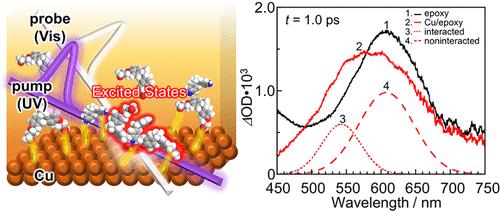Our official English website, www.x-mol.net, welcomes your feedback! (Note: you will need to create a separate account there.)
Electronic Interaction of Epoxy Resin with Copper at the Adhered Interface
Langmuir ( IF 3.9 ) Pub Date : 2024-04-23 , DOI: 10.1021/acs.langmuir.4c00711 Shintaro Saeki 1 , Daisuke Kawaguchi 2 , Yuta Tsuji 3 , Satoru Yamamoto 4 , Kazunari Yoshizawa 5 , Keiji Tanaka 1, 4
Langmuir ( IF 3.9 ) Pub Date : 2024-04-23 , DOI: 10.1021/acs.langmuir.4c00711 Shintaro Saeki 1 , Daisuke Kawaguchi 2 , Yuta Tsuji 3 , Satoru Yamamoto 4 , Kazunari Yoshizawa 5 , Keiji Tanaka 1, 4
Affiliation

|
A better understanding of the aggregation states of adhesive molecules in the interfacial region with an adherend is crucial for controlling the adhesion strength and is of great inherent academic interest. The adhesion mechanism has been described through four theories: adsorption, mechanical, diffusion, and electronic. While interfacial characterization techniques have been developed to validate the aforementioned theories, that related to the electronic theory has not yet been thoroughly studied. We here directly detected the electronic interaction between a commonly used thermosetting adhesive, cured epoxy of diglycidyl ether of bisphenol A (DGEBA) and 4,4′-diaminodiphenylmethane (DDM), and copper (Cu). This study used a combination of density functional theory (DFT) calculations and femtosecond transient absorption spectroscopic (TAS) measurements as this epoxy adhesive-Cu pairing is extensively used in electronic device packaging. The DFT calculations predicted that π electrons in a DDM molecule adsorbed onto the Cu surface flowed out onto the Cu surface, resulting in a positive charge on the DDM. TAS measurements for the Cu/epoxy multilayer film, a model sample containing many metal/adhesive interfaces, revealed that the electronic states of excited DDM moieties at the Cu interface were different from those in the bulk region. These results were in good accordance with the prediction by DFT calculations. Thus, it can be concluded that TAS is applicable to characterize the electronic interaction of adhesives with metal adherends in a nondestructive manner.
中文翻译:

环氧树脂与铜在粘合界面处的电子相互作用
更好地了解粘合剂分子在与被粘物界面区域的聚集状态对于控制粘合强度至关重要,并且具有重大的内在学术兴趣。粘附机制已通过四种理论描述:吸附、机械、扩散和电子。虽然界面表征技术已被开发来验证上述理论,但与电子理论相关的技术尚未得到彻底研究。我们在这里直接检测了常用的热固性粘合剂、双酚 A 二缩水甘油醚 (DGEBA) 和 4,4'-二氨基二苯基甲烷 (DDM) 的固化环氧树脂与铜 (Cu) 之间的电子相互作用。这项研究结合了密度泛函理论 (DFT) 计算和飞秒瞬态吸收光谱 (TAS) 测量,因为这种环氧粘合剂-铜配对广泛用于电子设备封装。 DFT 计算预测,吸附在 Cu 表面的 DDM 分子中的 π 电子流出到 Cu 表面,导致 DDM 上带正电荷。 Cu/环氧树脂多层膜(包含许多金属/粘合剂界面的模型样品)的 TAS 测量表明,Cu 界面处激发的 DDM 部分的电子态与本体区域中的电子态不同。这些结果与 DFT 计算的预测非常一致。因此,可以得出结论,TAS 适用于以非破坏性方式表征粘合剂与金属被粘物的电子相互作用。
更新日期:2024-04-24
中文翻译:

环氧树脂与铜在粘合界面处的电子相互作用
更好地了解粘合剂分子在与被粘物界面区域的聚集状态对于控制粘合强度至关重要,并且具有重大的内在学术兴趣。粘附机制已通过四种理论描述:吸附、机械、扩散和电子。虽然界面表征技术已被开发来验证上述理论,但与电子理论相关的技术尚未得到彻底研究。我们在这里直接检测了常用的热固性粘合剂、双酚 A 二缩水甘油醚 (DGEBA) 和 4,4'-二氨基二苯基甲烷 (DDM) 的固化环氧树脂与铜 (Cu) 之间的电子相互作用。这项研究结合了密度泛函理论 (DFT) 计算和飞秒瞬态吸收光谱 (TAS) 测量,因为这种环氧粘合剂-铜配对广泛用于电子设备封装。 DFT 计算预测,吸附在 Cu 表面的 DDM 分子中的 π 电子流出到 Cu 表面,导致 DDM 上带正电荷。 Cu/环氧树脂多层膜(包含许多金属/粘合剂界面的模型样品)的 TAS 测量表明,Cu 界面处激发的 DDM 部分的电子态与本体区域中的电子态不同。这些结果与 DFT 计算的预测非常一致。因此,可以得出结论,TAS 适用于以非破坏性方式表征粘合剂与金属被粘物的电子相互作用。



























 京公网安备 11010802027423号
京公网安备 11010802027423号